Name Nadezhda Krupskaya | ||
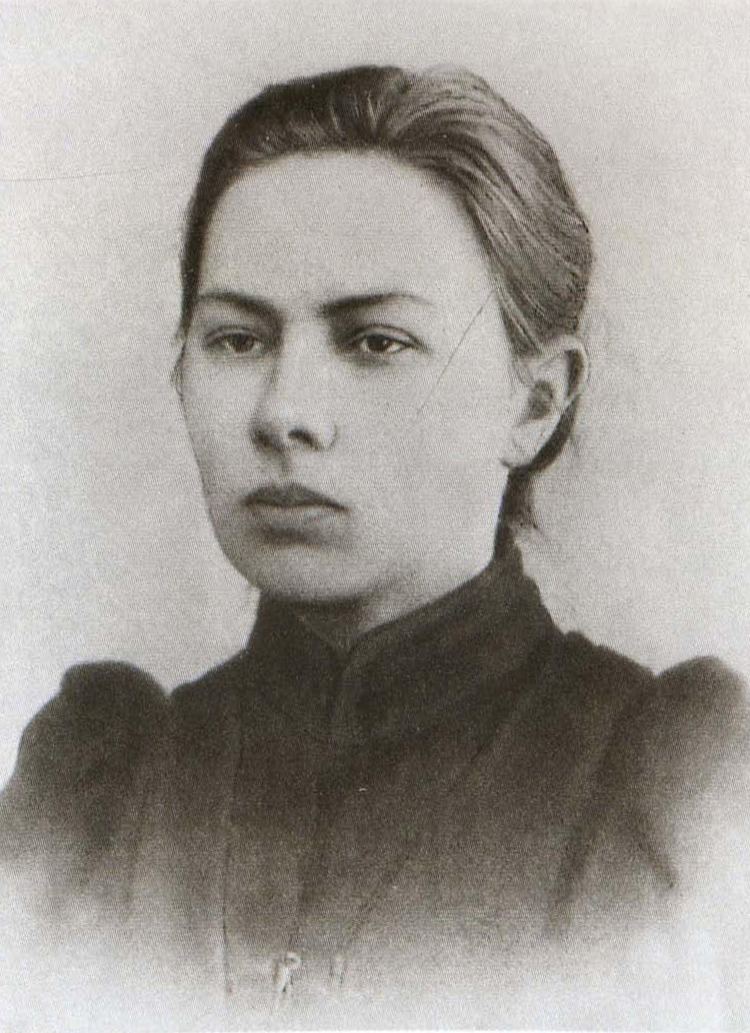 | ||
Full Name Nadezhda Konstantinovna KrupskayaNadezhda Konstantinovna Krupskaya Political party Books Memories of Lenin, Reminiscences of Lenin, On Labour-oriented Education and Instruction Parents Konstantin Ignat’evich Krupski, Elizaveta Vasilyevna Tistrova Similar People | ||
Massed crowd with lenin s wife nadezhda krupskaya listen to speaker during funera hd stock footage
Nadezhda Konstantinovna Krupskaya (Russian: Наде́жда Константи́новна Кру́пская; [nɐˈdʲeʐdə kənstɐnˈtʲinəvnə ˈkrupskəjə]; 26 February [O.S. 14 February] 1869 – 27 February 1939) was a Russian Bolshevik revolutionary, politician, and the wife of Vladimir Lenin from 1898 until his death in 1924. She served as the Soviet Union's Deputy Minister of Education from 1929 until her death in 1939.
Contents
- Massed crowd with lenin s wife nadezhda krupskaya listen to speaker during funera hd stock footage
- Nadezhda krupskaya
- Early life
- Married life
- Political career
- Views
- Soviet education and libraries
- Soviet education
- Legacy
- References
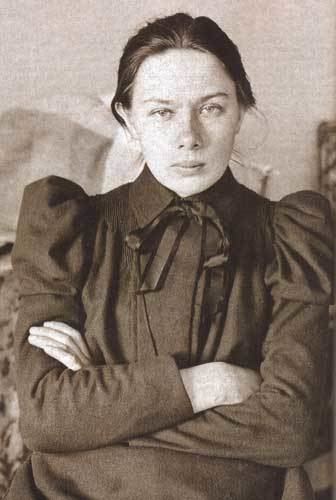
Nadezhda krupskaya
Early life
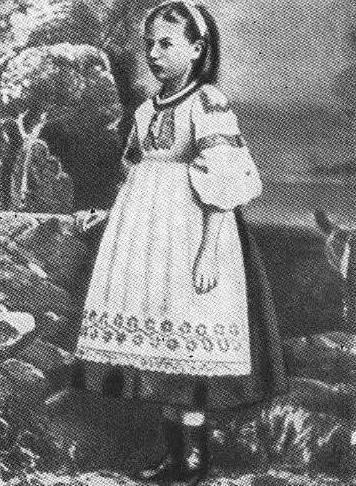
Nadezhda Krupskaya in 1876
Nadezhda Krupskaya was born to an upper-class but impoverished family. Her father, Konstantin Ignat'evich Krupski (1837–1897), was a Russian military officer and a nobleman of the Russian Empire who had been orphaned in 1847 at age nine. He was educated and given a commission as an infantry officer in the Russian Army. Just before leaving for his assignment in Poland, he married Krupskaya's mother. After six years of service, Krupski lost favor with his supervisors and was charged with "un-Russian activities." He may have been suspected of being involved with revolutionaries. Following this time he worked in factories or wherever he could find work. Just before his death, he was recommissioned as an officer.

Krupskaya's mother, Elizaveta Vasilyevna Tistrova (1836–1915), was the daughter of landless Russian nobles. Elizaveta's parents died when she was young and she was enrolled in the Bestuzhev Courses, the highest formal education available to women in Russia at the time. After earning her degree, Elizaveta worked as a governess for noble families until she married Krupski.

Having parents who were well educated, and of aristocratic descent, combined with firsthand experience with lower class working conditions likely led to the formation of many of Krupskaya's ideological beliefs. "From her very childhood Krupskaya was inspired with the spirit of protest against the ugly life around her."
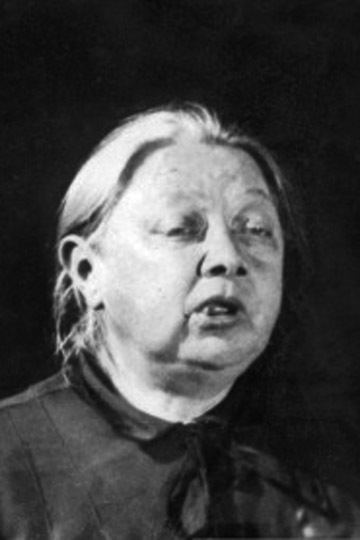
One of Krupskaya's friends from gymnasium, Ariadne Tyrkova, described her as "a tall, quiet girl, who did not flirt with the boys, moved and thought with deliberation, and had already formed strong convictions… She was one of those who are forever committed, once they have been possessed by their thoughts and feelings…." She briefly attended two different secondary schools before finding the perfect fit with Prince A.A. Obolensky's Female Gymnasium, "a distinguished private girls' secondary school in Petersburg." This education was probably more liberal than most other gymnasiums since it was noted that some of the staff were former revolutionaries.
After her father's death, Krupskaya and her mother gave lessons as a source of income. Krupskaya had expressed an interest in entering the education field from a young age. She was particularly drawn to Leo Tolstoy's theories on education, which were fluid instead of structured. They focused on the personal development of each individual student and centered on the importance of the teacher-student relationship.
This led Krupskaya to study many of Tolstoy's works, including his theories of reformation. These were peaceful, law-abiding ideas, which focused on people abstaining from unneeded luxuries and being self-dependent instead of hiring someone else to tend their house, etc. Tolstoy made a lasting impression on Krupskaya; it was said that she had "a special contempt for stylish clothes and comfort." She was always modest in dress, as were her furnishings in her home and office.
As a devoted, lifelong student, Krupskaya began to participate in several discussion circles. These groups got together to study and discuss particular topics for the benefit of everyone involved. It was later, in one of these circles, that Krupskaya was first introduced to the theories of Marx. This piqued her interest as a potential way of making life better for her people. Krupskaya began an in-depth study of the subject. This was difficult since such books had been banned by the Russian government. Consequently, revolutionaries had been collecting such books and keeping them in underground libraries.
Married life
Krupskaya first met Vladimir Ilyich Ulyanov (later known as Vladimir Lenin) in 1894 at a similar discussion group. Krupskaya was impressed by his speeches but not his personality, at least not at first. It is hard to know very much of the courtship between Lenin and Krupskaya as neither party spoke often of personal matters.
In October 1896, several months after Lenin was arrested, Krupskaya was also arrested. After some time, Lenin was sentenced to exile in Siberia. They had very little communication while in prison but before leaving for Siberia, Lenin wrote a "secret note" to Krupskaya that was delivered by her mother. It suggested that she could be permitted to join him in Siberia if she told people she was his fiancée. At that time, Krupskaya was still awaiting sentencing in Siberia. In 1898, Krupskaya was permitted to accompany Lenin but only if they were married as soon as she arrived.
In her memoirs, Krupskaya notes "with him even such a job as translation was a labour of love". Her relationship with Lenin was more professional than marital, but she remained loyal, never once considering divorce.
Krupskaya is believed to have suffered from Graves' disease, an illness affecting the thyroid gland in the neck which causes the eyes to bulge and the neck to tighten. It can also disrupt the menstrual cycle, which may explain why Lenin and Krupskaya never had children.
Upon his release, Lenin went off to Europe and settled in Munich where Krupskaya later met up with him upon her release (1901). After she had arrived the couple moved to London.
Political career

Nadezhda Krupskaya in the 1890s
Krupskaya's political life was active: she was anything but a mere functionary of the Bolshevik faction of the Russian Social Democratic Labour Party from 1903.
Leon Trotsky, who was working closely with Lenin and Krupskaya from 1902–1903, writes in his autobiography ("My Life", 1930) of the central importance of Krupskaya in the day-to-day work of the RSDLP and its newspaper, Iskra. "The secretary of the editorial board [of Iskra] was [Lenin's] wife [...] She was at the very center of all the organization work; she received comrades when they arrived, instructed them when they left, established connections, supplied secret addresses, wrote letters, and coded and decoded correspondence. In her room there was always a smell of burned paper from the secret letters she heated over the fire to read..."
Krupskaya became secretary of the Central Committee in 1905; she returned to Russia the same year, but left again after the failed revolution of 1905 and worked as a teacher in France a couple of years.
After the October Revolution in 1917, she was appointed deputy to Anatoliy Lunacharskiy, the People's Commissar for Education, where she took charge of Vneshkol'nyi Otdel the Adult Education Division. She became chair of the education committee in 1920 and was the deputy education commissar (government minister) from 1929 to 1939.

Nadezhda Krupskaya, Vladimir Lenin, Lenin's cat, and an American journalist in the Kremlin, 1920.
Krupskaya was instrumental in the foundation of Komsomol and the Pioneer movement as well as the Soviet educational system itself, including the censorship within it. She was also fundamental in the development of Soviet librarian-ship.
Krupskaya became a member of the Central Committee of the Communist Party of the Soviet Union in 1924, a member of its control commission in 1927, a member of the Supreme Soviet in 1931 and an honorary citizen in 1931.
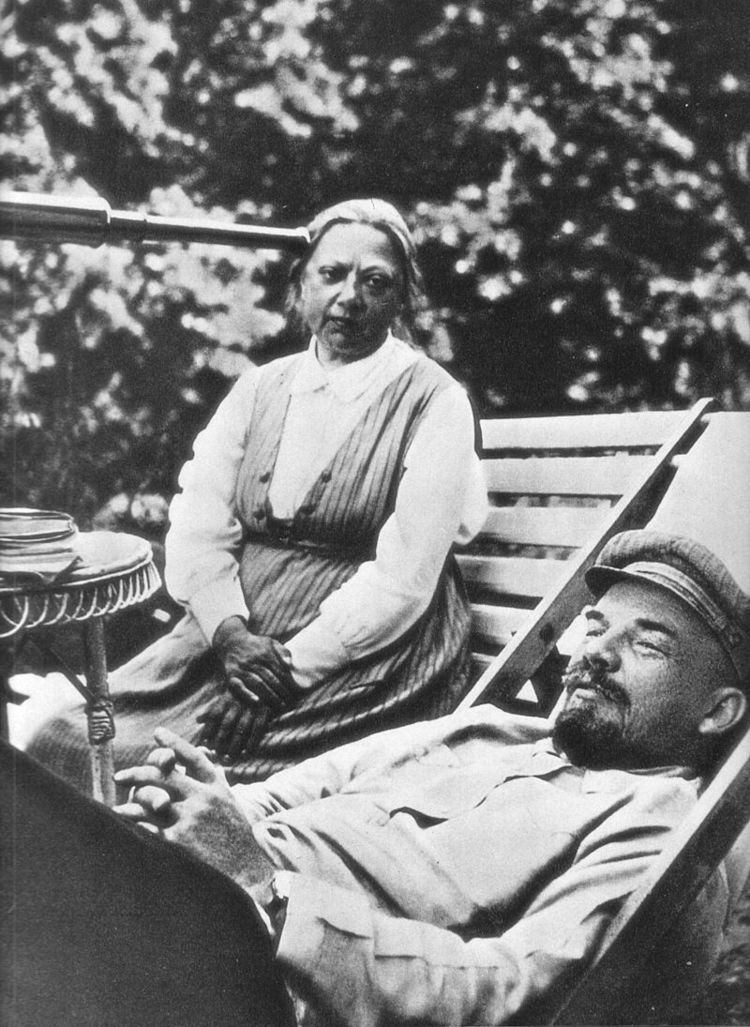
Krupskaya and Lenin, 1922.
Views
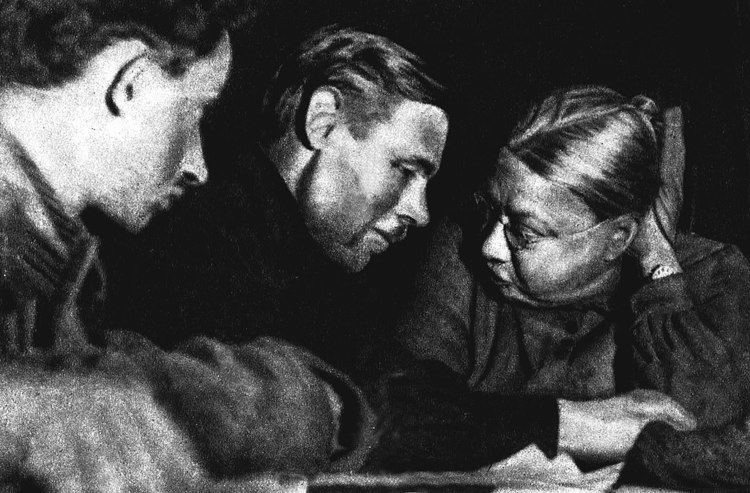
Nadezhda Krupskaya in 1931
After the death of Vladimir Lenin in January 1924, Krupskaya grew closer to the political positions of Grigory Zinoviev and Lev Kamenev in the great debates between the Leon Trotsky led Left Opposition, the Joseph Stalin led Centre, and the Nikolai Bukharin led Right Opposition. From 1922–1925, Zinoviev and Kamenev were in a triumvirate alliance with Stalin and the Centre, against Trotsky's Left Opposition. In 1925, Krupskaya attacked Leon Trotsky in a polemic reply to Trotsky's tract Lessons of October. In it, she stated that "Marxist analysis was never Comrade Trotsky's strong point."
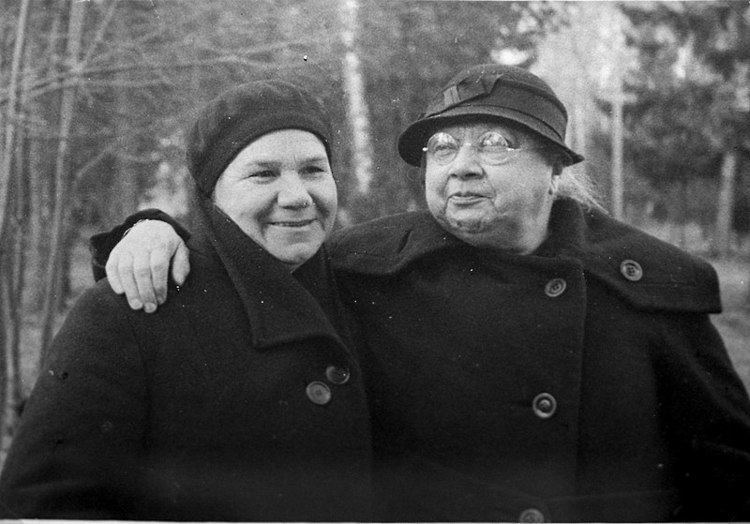
Krupskaya (right) in 1936.
In relation to the debate around Socialism in one country versus Permanent Revolution, she asserted that Trotsky "under-estimates the role played by the peasantry." Furthermore, she held that Trotsky had misinterpreted the revolutionary situation in post-World War I Germany. During both the Party Conference and Party Congress in 1925, she supported Grigory Zinoviev and Lev Kamenev against Joseph Stalin, as the troika of recent years broke up. In 1926, Krupskaya, Zinoviev and Kamenev went into an alliance with Trotsky's Left Opposition, to form the United Opposition, against Stalin. Krupskaya was quoted as saying in 1926 "Lenin was only saved from prison by his death". With state pressure growing to expel the United Opposition, Krupskaya eventually voted for the expulsion of Trotsky, Zinoviev and Kamenev from the Communist Party in December 1927, a position demanded by the Right Opposition and Stalin's Centre.
In 1936, she defended restrictions on abortion passed by the Soviet government in that year, arguing that they were part of a consistent policy pursued since 1920 to do away with the reasons to have an abortion.
Krupskaya wrote a memoir of her life with Lenin, translated in 1930 as Memories of Lenin and in 1970 as Reminiscences of Lenin,. The book gives the most detailed account of Lenin's life before his coming to power and ends in 1919. However, the text was edited by other hands after Krupskaya finished it and so may not be entirely reliable.
Soviet education and libraries
Before the revolution, Krupskaya worked for five years as an instructor for a factory owner who offered evening classes for his employees. Legally, reading, writing and arithmetic were taught. Illegally, classes with a revolutionary influence were taught for those students who might be ready for them. Krupskaya and other instructors were relieved of duty when nearly 30,000 factory workers in the area went on strike for better wages. Even after the revolution her emphasis was on "the problems of youth organization and education." In order to become educated they needed better access to books and materials.
Pre-revolutionary Russian libraries had a tendency to exclude particular members. Some were exclusively for higher classes and some were only for employees of a particular company's "Trade Unions". In addition they also had narrow, orthodox literature. It was hard to find any books with new ideas, which is exactly why the underground libraries began. Another problem was the low level of literacy of the masses. Vyborg Library, designed by Alvar Aalto was renamed the Nadezhda Krupskaya Municipal Library after the Soviet annexation of Vyborg.
Soviet education
The revolution did not cause an overnight improvement in the libraries. In fact, for a while there were even more problems. The Trade Unions still refused to allow general public use, funds for purchasing books and materials were in short supply and books that were already a part of the libraries were falling apart. In addition there was a low interest in the library career field due to low income and the libraries were sorely in need of re-organization.
Krupskaya directed a census of the libraries in order to address these issues. She encouraged libraries to collaborate and to open their doors to the general public. She encouraged librarians to use common speech when speaking with patrons. Knowing the workers needs was encouraged; what kind of books should be stocked, the subjects readers were interested in, and organizing the material in a fashion to better serve the readers. Committees were held to improve card catalogs.
Krupskaya stated at a library conference: "We have a laughable number of libraries, and their book stocks are even more inadequate. Their quality is terrible, the majority of the population does not know how to use them and does not even know what a library is."
She also sought better professional schools for librarians. Formal training was scarce in pre-revolutionary Russia for librarians and it only truly began in the 20th century. Krupskaya, therefore, advocated the creation of library "seminaries" where practicing librarians would instruct aspiring librarians in the skills of their profession, similar to those in the West. The pedagogical characteristics were however those of the Soviet revolutionary period. Librarians were trained to determine what materials were suitable to patrons and whether or not they had the ability to appreciate what the resource had to offer.
Krupskaya also desired that librarians possess greater verbal and writing skills so that they could more clearly explain why certain reading materials were better than others to their patrons. She believed that explaining resource choices to patrons was a courtesy and an opportunity for more education in socialist political values, not something that was required of the librarian. They were to become facilitators of the revolution and, later, those who helped preserve the values of the resulting socialist state.
Krupskaya was a committed Marxist for whom each element of public education was a step toward improving the life of her people, granting all individuals access to the tools of education and libraries, needed to forge a more fulfilling life. The fulfillment was education and the tools were education and library systems.
